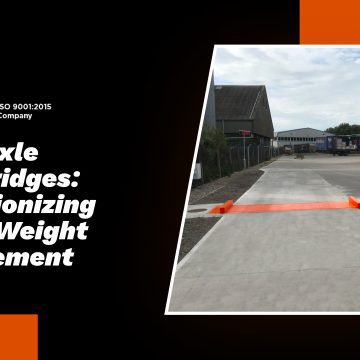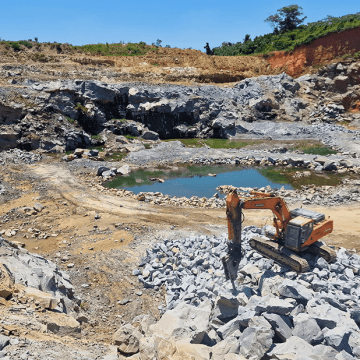Home » Industrial Weighing Products » Weighbridges » High Speed Weighing
High Speed Weighing
The Griffith Elder high-speed weighing Highway Weigh-In-Motion system uses three rows of very high accuracy Quartz Sensors to detect and weigh each axle of every vehicle. The axle weights automatically add together to give axle group weights and gross vehicle weights.
- Features
A dual wheel sensor detects the width of the tyres and whether there is a dual wheel on an axle. An inductive loop recognises each vehicle separately from the next vehicle. Additionally, an automatic camera records the license plate. This information, held together with the weight information of the vehicle, determines the classification of the vehicle automatically. The camera can also have software for European, Arabic, Chinese or other language license plates.
If required, variable message signs can be used to tell vehicles what to do after being weighed.
The Quartz Sensors are the heart of the High Speed Weigh-In-Motion system. Manufactured from the highest quality natural quartz, the sensors detect the weight of each wheel as it crosses them in the road. Three rows of sensors are used in each lane of the highway to give the most accurate weight of each axle as it passes. Times between sensors also give the speed of the vehicle and distances between axles.
Features of High Speed Weighing
- 3 rows of Quartz Sensors for high accuracy
- Maximum axle weight 30 tonnes
- Sensor overload capacity 45 tonnes per axle
- Gross weight accuracy + – 5%
- Vehicle Speed 3 to 130 km/hr
- License plate recognition camera
- Automatic vehicle classification
- Speed monitoring
- Speed accuracy + – 1 km/hr
- Dual wheel sensor
- Induction Loop to recognise new vehicle
- Database to store results
- High Speed Weigh-In-Motion
High-speed weighing in motion operates between speeds of 3 and 130 kilometres per hour. The HSWIM system automatically captures traffic travelling between these speeds.
Sensors in the road are Quartz and complement the inductive loop sensors. These recognise vehicle separation, to detect axle weights as a vehicle drives over them. Typically the Quartz Chrystal Piezoelectric sensors are accurate to within 10% on a single axle and within 5% on the gross vehicle weight. Therefore, they are generally acceptable for deciding which vehicles should be directed off the road to a weigh station. However, in some countries, they are accepted as being suitable to prosecute overweight vehicles because the tolerance is such that the 5% discrepancy works in favour of the vehicle owners.
Sensors are usually arranged in sets of six in each lane of the highway to give maximum accuracy. The road surface needs to be within certain tolerances, as detailed within the EU document COST 323, to work with the highest accuracy. Notably, local installation conditions will also influence accuracies.
A single Dual Wheel Sensor is normally also installed with the HSWIM sensors so that classification can be correctly determined, including double wheeled axles.
- Weigh-Station Pre-Screening
One of the major uses of High-Speed Weigh-in-Motion is to decide which vehicles should be pulled off the highway to be further examined. This includes infringement in weights allowable, and more recently, taxation and insurance infringements and vehicle size (height and width) discrepancies. In-Highway equipment detects all these aspects of the vehicles fully. In addition, each vehicle can be looked up in a national database and former infringements of the regulations can be noted in real-time. Therefore, the personnel at the weigh station knows in advance of a vehicle arriving what they are looking for.
Using CCTV surveillance systems in conjunction with in-highway monitoring systems gives detailed video evidence of the presence and defects of a vehicle. This is therefore often used. This is usually stored separately from the national database of vehicles due to the large size of files created at each weighing site. However, with appropriate software, both systems can be viewed in synchronised time. The video reinforces the data collection for each vehicle and investigation.
For more information on the Single-Axle Low-Speed Weigh-in-Motion system, please refer to the document named Single Axle Overload Detection.
- Vehicle Counting Function
Apart from weighing vehicles, the induction loop and the dual wheel sensor together can be used as a reasonably priced vehicle counting, vehicle speed, and classification system, with vehicle density and road use statistics easily developed from the data collected. Data stores in a database at the road station. This can be retrieved either on site using a laptop to plug into the data logger, or via Ethernet using a remote connection.
- Data Transfer to Central Database
Records send in real-time to a central database via the Industrial Computer program, once completed from each WIM station. The data transfer program will run in the background and automatically try to send a record when completed. In the event of no communication with the central database, it will keep trying until a connection is made. It then sends all complete records since the last good connection.
The normal method of data transfer is across the internet. To ensure the data cannot be intercepted or corrupted all data is encrypted between the head office and the outlying stations.
The Central Database collates all the results from the individual roadside stations so that reports from the central database can include vehicles that have visited more than one station. For instance, it is possible to report on a particular vehicle to see how often it is in contravention of the weight limit rules. Or, a report could be run to detect a particular company to check on what has been delivered.
Find out more about our Highway Weigh-In-Motion system
Contact us on: +44 (0)1284 719619 or sales@griffith-elder.com to find out more information about our High Speed Weighing solutions.
Contact Brochure








